Leitz + beh 7x50 Porro II
| Zwischen den Weltkriegen stellte Leitz auch Porro-2-Modelle mit Werten 7x50 und 10x50 her. In einem Katalog von 1931 trägt das zivile 7x50 die Modellbezeichnung "Monosept" (s. u.). Das hier gezeigte Exemplar ist entspricht diesem, ist jedoch nur die linke Hälfte eines Fernglases. Das gezeigte beh 7x50 könnte ebenfalls nur eine linke Hälfte sein, es zeigt aber keine Spuren einer abgesägten Fernglasbrücke und ist daher möglicherweise eine monokulare Anfertigung während des Krieges, z.B. aufgrund von Materialmangel. | Between the world wars, Leitz also produced a Porro II model with 7x50 specifications. In a catalog of 1931 the civilian 7x50 has the model name "Monosept" (cf. below). The copy shown here corresponds to this, but is only the left half of a binoculars. The depicted beh 7x50 could also be only a left half, but it does not show any traces of a binocular bridge, and may therefore be a monocular production during the war, for isntance due to lack of material. |
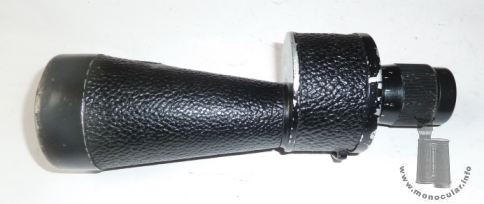

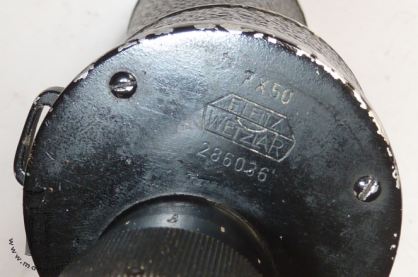
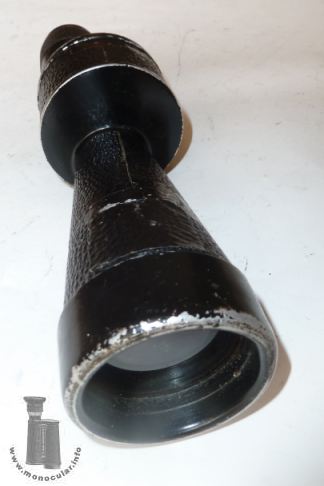
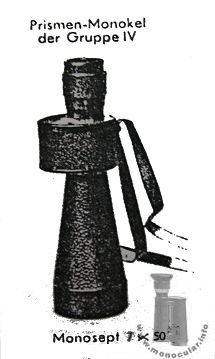
| Das zivile Modell hat eine komplette Beschriftung mit "7x50", Leitz-Logo und Seriennummer 286035 auf dem zweifach verschraubten Deckel, schwarz lackierte Aluteile und mit strukturiertem Vulkanit überzogene Prismengehäuse und konischen Tubus. Die Objektivlinse ist blau vergütet, was entweder auf eine sehr späte Herstellung in den End-1930er Jahren oder während des 2. Weltkrieges hindeutet, oder ein Ersatz bei der Umgestaltung zu einem Monokular geschehen sein könnte. Das beh-Modell hat eine anthrazit-graue Lackierung, ist unvergütet und hat einen mit einem Überwurfring gesicherten Deckel mit einem Trockenluftventil. Der Deckel ist mit "7x50" und "beh 438229" beschriftet. Im Prismengehäuse ist am Boden eine andere Nummer eingeritzt. | The civilian model has complete inscriptions with "7x50", the Leitz logo and a serial number 286035 on the cover fixed with two screws, black lacquered aluminum parts and a prism housing covered with structured vulcanite, and conical tube. The objective lens is coated blue, which indicates either a very late production in the late 1930s or during the World War II, or a replacement was made when converting it into a monocular. The beh model has an anthracite-gray finish, is uncoated and has a cover secured with a retainer ring. It comes with a dry-air valve. The lid is labeled "7x50" and "beh 438229". A different number is scratched into the prism housing. |
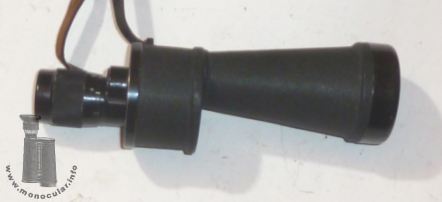
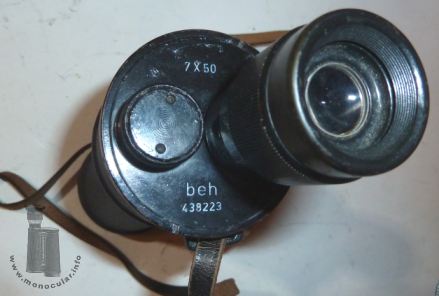

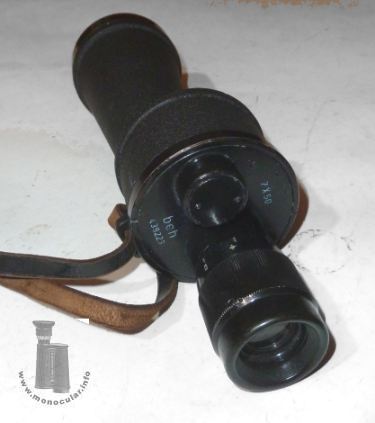
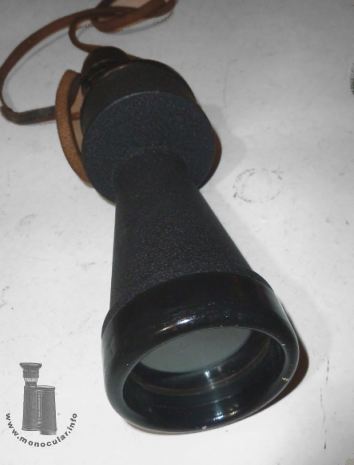
| Die 7x50er sind 21,4 - 22mm lang. Das runde Prismengehäuse ist 43 bzw. 46mm lang und 64mm im Durchmesser. Der konische Tubus ist 100mm bzw. 96mm lang und verbreitert sich von 35 auf 60 bzw. 58mm, gefolgt beim zivilen Modell von einer 24mm langen und 64mm breiten Objektivverblendung, bei dem militärischen Modell gefolgt von einem 8mm langen und 63mm breiten geraden Endstück, an dem die 64mm messende und 18mm lange Objektivverblendung geschraubt ist. Beim zivilen Leitz ist das Okularstück 32mm, der Fokussierungsring 37mm und die Augenmuschel 33mm im Durchmesser, beim beh ist das Okular 31mm, der Fokussierungsring 36mm und die Augenmuschel 34mm im Durchmesser. Das 7x50 wiegt 479g bzw. 520g. | The 7x50s are 21.4 - 22mm long. The round prism housing is 43 or 46mm long and 64mm in diameter. The conical tube is 100mm or 96mm long and widens from 35mm to 60mm and 58mm respectively, followed by a 24mm long and 64mm wide objective frame in the civilian model. On the military model the conical tube is followed by an 8mm long and 63mm wide straight end piece, onto which the 64mm wide and 18mm long obejctive frame is screwed. The eyepiece of the civilian model is 32mm, the focus ring is 37mm and the eyecup is 33mm in diameter. The eyepiece of the beh model is 31mm, the focus ring is 36mm and the eyecup is 34mm in diameter. The 7x50 weighs 479g or 520g. |
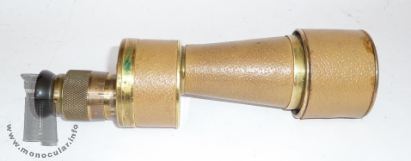
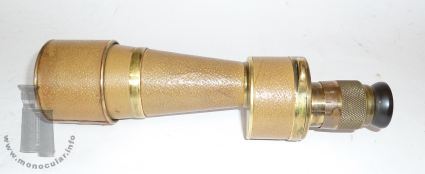
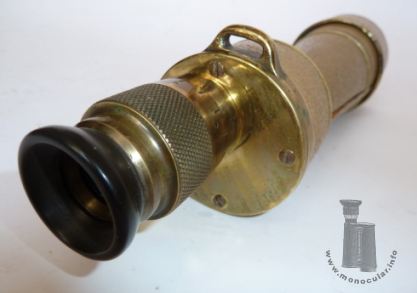

| Ein 10x50 Modell mit ausziehbarer Sonennblende (Marine-Modell) stammt aus den 1920er Jahren und gehört aufgrund des Materials und Bauart zu den so genannten Messingläser-Modellen (vgl. "Monodix". Mit ausgezogenr Sonnenblende ist es 24,5cm lang. Der Deckel ist 4fach verschraubt. Die Messignteile wurden blank poliert und das Gehäuse mit einem hellbraunen Leder neu ummantelt. Es gibt keine Deckelbeschriftung. Auch hier ist anzunehmen, dass es sich einmal um ein Doppelglas handelte. | A 10x50 model with extendable sunshade (marine model) dates from the 1920s and belongs to the so-called brass models ("Messingglas") due to the material used and its specific construction (cf. "Monodix". It is 24.5cm long with its sunshade. The cover has 4 screws. The brass parts are polished and the housing was covered with a light brown leather. There are no cover inscription. Again, one can assume that it was once a binoculars. |
Fotos: Zeun

